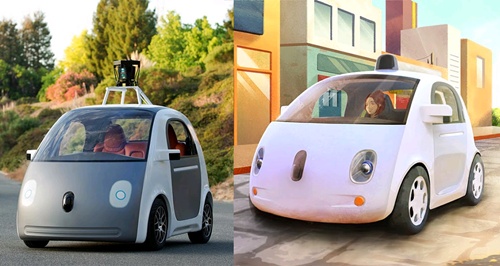Google to make its own self-driving cars
29 May 2014
Google plans to make its own self-driving cars, rather than modifying vehicles built by other manufacturers.
The car would have a stop-go button but there would be no controls, steering wheel or pedals.
 | |
| A very early version of Google's prototype vehicle (left) and an artistic rendering of the vehicle (right) |
The company's plans were revealed by co-founder Sergey Brin at a conference in California.
"We're really excited about this vehicle - it's something that will allow us to really push the capabilities of self driving technology, and understand the limitations," said Chris Urmson, director of the company's self-driving project.
He added the cars would help "improve people's lives by transforming mobility".
However a number of researchers working in the field are investigating the technology for potential downsides.
They believe by relieving people from having to drive, the technology could end up adding to traffic problems and worsening urban sprawl.
According to the BBC which had been granted access to the Google team to preview the technology in action, the car looked almost out of a cartoon, without the traditional bonnet at the front, and the wheels pushed to the corners.
Meanwhile, Urmson said in a blog post: "Ever since we started the Google self-driving car project, we've been working toward the goal of vehicles that can shoulder the entire burden of driving.
"Just imagine: You can take a trip downtown at lunchtime without a 20-minute buffer to find parking. Seniors can keep their freedom even if they can't keep their car keys. And drunk and distracted driving? History."
The company plans to build about 100 prototypes, and the summer would see it develop versions of the cars that with manual controls, PCMag.com reported.
"If all goes well, we'd like to run a small pilot program here in California in the next couple of years," Urmson said.
As regards safety, Google points out that sensors that remove blind spots, gave the vehicle the ability to detect objects up to two football fields away in all directions. Currently the vehicles too do not make more than 25 mph, so Google's vehicle did not exactly have a lead foot.
"On the inside, we've designed for learning, not luxury, so we're light on creature comforts, but we'll have two seats (with seatbelts), a space for passengers' belongings, buttons to start and stop, and a screen that shows the route - and that's about it," Urmson wrote.






















